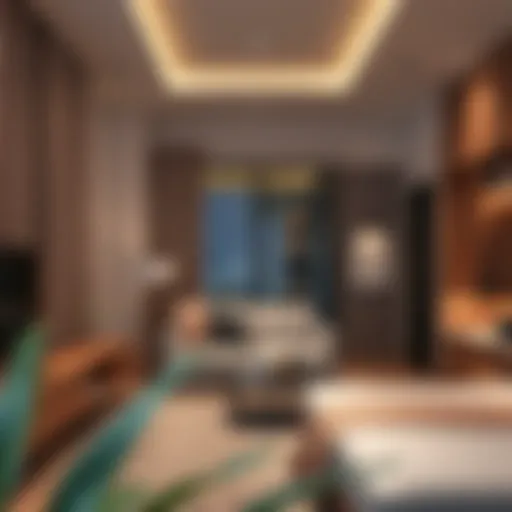The Sea Tower: Architectural Innovation and Real Estate Insights


Intro
In recent years, the skyline of Dubai has undergone remarkable transformations, marked by the introduction of unique structures known as sea towers. These structures not only redefine the architectural landscape but also represent a lucrative opportunity in the ever-evolving real estate market. Understanding what sea towers embody goes beyond recognizing their aesthetic appeal; they embody a blend of innovation, sustainability, and investment potential in a city celebrated for its audacious ventures.
This comprehensive exploration seeks to dissect the characteristics that make sea towers stand out in Dubai's saturated real estate sector. From their design intricacies to the environmental ramifications, every aspect unfolds a narrative of progressive urban development. Moreover, comprehending market trends and economic indicators shapes the foundation upon which potential investors and homeowners can build informed decisions. As such, this article aims to serve as a guiding compass for navigating the intricate landscape of waterfront properties in Dubai, characterized by both breathtaking views and substantial financial prospects.
Prelude to Sea Towers
The concept of sea towers has gained traction, making waves in the realms of architecture and real estate. These structures, reaching for the sky while anchored in the ocean, stand testament to human ingenuity and adaptation. Not only do they showcase the artistry of modern design, but they also tackle the pressing challenges posed by urbanization and climate change.
Sea towers serve multiple purposes, blending living spaces, commercial areas, and recreational facilities, all while establishing a connection between land and sea. The rise of these architectural marvels speaks volumes about our collective vision to embrace sustainability and innovation in urban development. With urban landscapes continuously expanding, sea towers emerge as a sensible solution for accommodating the growing population without encroaching too heavily on precious land resources.
Importance and Benefits
- Architectural Innovation: Sea towers push the boundaries of engineering and design, frequently utilizing cutting-edge materials and techniques to enhance structural integrity and aesthetic appeal.
- Enhanced Living Experiences: Living within a sea tower often means breathtaking views of the ocean, immediate access to beaches, and a unique lifestyle that interplays with nature. This can drastically elevate the quality of life for residents.
- Potential for Sustainability: Many developers are incorporating green technologies—like solar panels and water recycling systems—into these structures, aiming to minimize environmental footprints and promote sustainable living.
- Economic Growth: Sea towers often stimulate local economies through tourism and investment opportunities. They can attract various businesses and create jobs, contributing positively to community development.
- Navigating Real Estate Opportunities: For investors and homeowners, understanding the intricacies of sea towers can open up avenues for lucrative returns. A well-located sea tower within a thriving market can offer substantial long-term value.
In summary, the exploration of sea towers delves beyond mere architectural prowess—it highlights their potential to reshape land use, promote sustainable practices, and boost economic opportunities in populous areas. As we proceed through the various segments of this article, we will unravel historical contexts, architectural features, and the pressing environmental considerations associated with these modern marvels.
Sea towers are more than just buildings; they are a vision for future living by the water, harmonizing life and nature in an increasingly urban world.
Historical Context of Sea Towers
Understanding the historical context of sea towers provides valuable insights into their architectural evolution and cultural significance. These structures don't just symbolize modernity; they reflect historical necessities and adaptations in the face of geographical and climatic challenges. As coastal communities expanded over centuries, the need for sea towers emerged not just as a way to utilize land, but also as a juncture between man-made structures and nature. The design and integration of sea towers into existing coastlines illuminate how societies have learned to harmonize living spaces with environmental requirements.
Early Examples in Architecture
Historically, sea towers have their roots in various coastal civilizations. Ancient cultures like the Phoenicians and the Greeks constructed seaside structures that served both as defensive fortifications and as lighthouses. The Tower of Hercules in Spain, built during the Roman Empire, stands as a prime example of utility meeting artistry. This ancient lighthouse has guided sailors for over 2,000 years, merging architectural prowess with functional necessity.
In the Middle Ages, lighthouses evolved further, often featuring tall structures that guided merchant ships through dangerous waters. These towers were marked by their sturdy stone construction, reflecting the times' architectural norms and the need for stability against the elements. When observing the development of these architectural feats, one can see the transformation from basic lookout points, such as those built on rocky outcrops, to intricate towers that are integrated into urban planning.
As the 19th century rolled around, the industrial revolution brought about new construction materials and techniques, allowing for taller and more durable towers. The shift towards steam power and later electric illumination redefined what these towers could achieve, marking a pivotal point in their architectural legacy. Their influence stretched beyond mere navigation, embedding them deeper within the cultural and economic fabric of coastal towns.
Influence of Coastal Settlements
The evolution of coastal settlements significantly shaped the design and purpose of sea towers. Historically, settlements near coastlines were often among the first to engage in maritime trade, resulting in the necessity for structures that catered to shipping and defense. As settlements grew, so too did the importance of protecting these burgeoning communities from natural disasters such as storms and rising tides.
Take, for example, Venice, a city famous for its canals and unique architectural structures. The Venetian sea towers served multiple purposes, acting as watchtowers and providing flood defenses. The structure and design were influenced by the demand for merchant safety, reflecting a combination of functionality and aesthetic appeal.
Moreover, as these coastal towns experienced fluctuations in population density, the design of their sea towers adapted accordingly. Towers equipped with living quarters became essential in some locales, allowing lighthouse keepers to maintain vigilance while cultivating a community around their maritime expertise.
The integration of sea towers into urban development also encourages public engagement; parks and walkways often sprout around these architectural giants, fostering a sense of community and interaction. This synergy between architecture and urban life illustrates how sea towers have transcended their original purposes to become pillars of cultural identity in many coastal cities.
Architectural Features of Sea Towers
The architectural features of sea towers constitute not just their aesthetic appeal but also their functional integrity, resilience against environmental challenges, and ability to profoundly shape urban landscapes. As coastal structures, they navigate the fine line between beauty and practicality, making them pivotal within the broader context of real estate opportunities. In a city like Dubai, where innovation meets tradition, these towers symbolize a marriage between cutting-edge design and real estate potential that eagerly attracts investors, homeowners, and urban planners alike.
Design Innovations
The world of sea towers is marked by design innovations that push the envelope of contemporary architecture. Many architects are opting for sleek, aerodynamic shapes that not only catch the eye but also aid in reducing wind resistance and minimizing structural stress during storms.
Elements to consider in these designs include:
- Cantilevered structures: These extensions often create engaging outdoor spaces, offering breathtaking views while maintaining stability. The way these structures jut out can provide added value for living spaces and public areas alike.
- Biophilic design: Integrating nature within the construction, like vertical gardens or water features, elevates the living experience. This approach promotes sustainability while enhancing the aesthetic quality of the immediate surroundings.
- Smart technology integration: Features like automated shading systems and climate-responsive materials are becoming increasingly prevalent. These innovations ensure that energy efficiency is at the forefront, appealing directly to the green-minded investor.
"The design of sea towers serves as both a refuge from the everyday and a sentinel against nature, yielding a dual function that is nothing short of transformative."
Materials and Sustainability


In discussing materials, the pivotal choice for structures like sea towers often leans towards those that endure the ocean’s rigors. High-strength concrete, treated glass, and steel frameworks not only provide safety but also contribute to the towers' durability.
Core aspects of material selection and sustainability include:
- Corrosion-resistant materials: Due to their proximity to saltwater, utilizing materials that withstand corrosion is crucial. This durability not only extends the structure's lifespan but also represents a sound financial decision for investors.
- Energy-efficient options: Solar panels, green roofs, and rainwater harvesting systems are integral parts of sustainable sea tower projects. These solutions attract environmentally-conscious buyers who value long-term savings on utilities.
- Local sourcing: Using materials sourced from local suppliers minimizes the carbon footprint associated with transportation, thereby aligning with sustainable practices that appeal to a socially aware market.
Each of these features intertwines, playing a significant role in determining how these towers respond to current environmental conditions, ultimately shaping their market viability in a competitive real estate arena.
Environmental Impact of Sea Towers
The construction of sea towers has raised various questions regarding their effects on the environment. As these structures stand tall amidst the waves, they bring both opportunities and challenges that deserve thoughtful exploration. Understanding the environmental impact is imperative, not just for the ecological well-being, but also for the sustainability of the investment and the quality of life for future residents. This section delves into the intricate relationship between sea towers and their surrounding ecosystems, alongside the pressing issues posed by climate change.
Ecosystem Considerations
The placement of sea towers often disrupts marine life, which is a crucial factor when considering the broader environmental impact. During construction, the natural habitats of marine creatures can be altered or even destroyed. This includes the displacement of fish, coral reefs, and other aquatic organisms, which are often the backbone of the local ecosystem. To mitigate such impacts, architects and engineers are encouraged to collaborate with marine biologists to conduct thorough environmental assessments prior to breaking ground.
Some innovative strategies being discussed involve creating artificial reefs around the base of the towers, aiming to foster marine life rather than deter it. This can enhance biodiversity and even increase local fish populations, ultimately benefiting the ecosystem.
Additionally, potential technologies like bioengineered materials that promote algal growth on the tower's exterior can serve to absorb excess carbon dioxide, further demonstrating a conscientious approach to construction. Thoughtful designs that consider local ecosystems can have lasting positive effects.
"The harmony between human architecture and nature is not just a goal but a necessity for sustainable development in coastal regions."
Climate Change Challenges
As the climate continues to shift, the sea towers face challenges that are multifaceted. Sea level rise remains a significant concern. Structures that once appeared secure may find themselves increasingly threatened by unpredictable water levels and storm surges. This unpredictability demands that future designs are resilient and capable of withstanding nature's wrath.
Moreover, sea towers must also consider energy consumption during and after construction. Utilizing renewable energy sources such as solar or wind could significantly lessen the carbon footprint of these colossal structures. Some projects are pioneering energy-efficient designs, harnessing natural light and improving insulation—a step towards greener buildings.
Upgrading to intelligent building systems can also offer advantages. By implementing smart technologies that monitor environmental conditions, these towers can maintain a comfortable living space while conserving resources. As climate change escalates, adapting architecture to predict and respond to climatic shifts cannot be overlooked.
Emphasizing sustainability not only addresses imminent environmental concerns but also positions investors positively in an increasingly eco-conscious market. Understanding these environmental dimensions is invaluable for homeowners, agents, and investors alike, shaping a future where architecture aligns with ecological stewardship.
The Integration of Sea Towers in Urban Planning
Urban planning is a finely-spun web of considerations where every thread counts. The inclusion of sea towers in this equation brings a mix of opportunities and challenges, particularly in a bustling metropolis like Dubai. Sea towers not only provide a unique aesthetic value to the skyline but also adapt well within the coastal framework, generating a symbiotic relationship between urban life and marine environments.
Zoning Regulations and Compliance
Zoning regulations play a pivotal role in determining how sea towers integrate into existing urban landscapes. These regulations are like the rulebook for real estate development, setting the stage for what can be built, where, and how. For example, in Dubai, the local authority often emphasizes minimizing environmental impacts and maximizing space usability.
- Height Restrictions: Some areas might impose restrictions on how tall a sea tower can rise. This is crucial given that taller structures can impact views and natural light access for surrounding buildings.
- Density Requirements: The regulations define how many units per square meter can be constructed, ensuring that developments do not lead to overcrowding.
- Environmental Compliance: Regulations often include checks to protect marine ecosystems. Sea towers must implement sustainable practices, such as using eco-friendly materials and respecting local wildlife.
Navigating these regulations is vital for developers and investors. A thorough understanding of local codes is essential to avoid costly setbacks or legal disputes that can arise from non-compliance.
Public Spaces and Accessibility
Public spaces around sea towers also warrant attention, as they enhance community engagement and accessibility. Integrating these structures into urban areas means considering not just the building but also how people will connect with it and the surrounding landscape.
- Walkability: Efforts should be made to ensure access to the towers without overwhelming the pedestrian experience. With ample pathways, parks, and seating areas, public spaces can bolster community interaction.
- Transportation Links: Convenient transportation options, such as nearby metro stations or bus stops, make it easier for residents and visitors to access these sea towers. Well-planned transport strategies contribute to reducing vehicular congestion and promote greener commuting alternatives.
- Designated Waterfront Areas: Sea towers should enhance the appeal of waterfront areas with gathering spots that might include cafes or viewing platforms. These spaces not only serve residential needs but foster tourism and local business growth.
"Urban planning is about creating spaces that feel as great to inhabit as they look from the skyline. Sea towers exemplify that goal, bridging aesthetic beauty and communal practicality."
By tackling zoning regulations and prioritizing public spaces, the future of sea towers looks promising, contributing significantly to Dubai's ever-evolving architectural landscape.
For additional insights into urban planning and zoning, you can explore resources like Wikipedia and Britannica.
Economic Implications of Sea Towers


The economic implications of sea towers are significant, especially within the context of Dubai's rapidly expanding real estate market. These architectural feats not only showcase innovative design but also carry with them profound economic prospects and considerations for investors, homeowners, and urban planners alike. Understanding the financial landscape surrounding sea towers helps stakeholders make informed decisions, thereby enhancing investment potential and community development.
Cost of Construction
The cost of constructing a sea tower is an essential factor to consider. This starts with the land procurement, which is often at a premium due to the proximity to waterfronts. Then there is the construction phase, where factors like labor costs, materials, and compliance with specialized engineering for resilience against oceanic conditions come into play. Sea towers must endure not just the usual wear and tear of time, but also natural forces like waves and storms.
In specific terms, the estimated cost ranges widely. For example, a sea tower in Dubai can cost anywhere from $250 million to over a billion dollars, depending on its design and height. This high initial outlay can be daunting, yet it sets the foundation for long-term revenue generation via luxury residential sales or commercial leasing.
Another factor to consider is the ongoing maintenance cost, which may also be higher for sea towers due to their unique environmental challenges. Therefore, prospective investors should carry out meticulous cost-benefit analyses before committing.
Long-Term Value Assessment
Evaluating the long-term value of sea towers requires looking beyond just immediate gains. Location is a significant aspect that influences value appreciation. Properties positioned along the coastline often see higher demand due to aesthetic and lifestyle benefits. Furthermore, as urban landscapes evolve, sea towers have the potential to become premium locations for both living and business.
Statistically, waterfront properties typically appreciate faster than those situated further inland. The allure of being near water, combined with high-quality amenities typically provided in sea towers, makes these properties highly desirable. Furthermore, global investment trends show a surge in eco-friendly and innovative architectural designs, which contribute to increased property value over time.
It's also vital to consider regulatory environments. Areas that foster supportive building regulations and urban planning initiatives can offer significant advantages in property value retention. Investors can expect benefits from a well-thought-out long-term strategy that includes adapting to market demands and leveraging technological advancements.
In summary, the economic implications of sea towers go much deeper than the initial investments. They represent both an anchor of urban development and a beacon of future income potential. Investors need a thorough understanding of construction costs and long-term value assessments to navigate successfully in this promising real estate landscape.
"Understanding the economic implications of sea towers is not merely about numbers; it is about envisioning the future of urban living and sustainability in Dubai."
For a more comprehensive breakdown of investment trends, you can visit resources like Investopedia, or explore community discussions at Reddit. For deeper insights into real estate economics, reviewing studies from sites like Britannica may also prove beneficial.
Investment Potential in Sea Towers
The sea towers hold a significant position in the evolving landscape of real estate in Dubai. Their strategic architecture not only caters to luxurious living experiences but also plays a pivotal role in shaping investment dynamics. Buyers and investors are increasingly drawn towards these properties, primarily due to their unique offerings. The blend of modernity with natural surroundings creates a niche that stands out in traditional real estate markets.
Market Trends and Insights
The market for sea towers has shown remarkable growth over recent years. Investors are keenly observing a few noteworthy trends that guide their decision-making:
- Increasing Demand for Waterfront Properties: The allure of ocean views remains irresistible. There’s a noticeable uptick in buyers seeking properties that offer a slice of paradise, and sea towers fit this requirement perfectly.
- Rental Yields: Investors are discovering that these towers often yield higher returns compared to standard apartments. A well-positioned sea tower can command premium rental rates due to its location and amenities.
- Sustainable Living: As more people become environmentally conscious, the demand for sustainable construction in real estate is on the rise. Sea towers built with eco-friendly materials tend to attract a specific demograph of investors.
"Investing in sea towers is not just about the property itself; it’s about being part of a lifestyle that many aspire to have."
Risk Factors to Consider
Although the investment potential appears promising, it’s essential to tread carefully. Here are some risk factors worth noting:
- Market Volatility: Real estate markets can fluctuate. A sudden downturn can impact values significantly, making thorough market research crucial.
- Environmental Issues: Proximity to the water comes with challenges, like erosion or flooding. Investors need to consider potential impacts from climate change and local regulations that can affect property values.
- Regulatory Challenges: Zoning laws and building codes can differ substantially across regions. Ensuring compliance isn’t just a legal step; it’s essential for the viability of the investment.
Comparative Analysis of Sea Towers Globally
The concept of sea towers transcends geographical borders. While Dubai might be making headlines, a comparative glance at global sea towers unveils an enriching narrative about architectural innovation and urban resilience. Understanding these structures in various contexts can give investors, homeowners, and real estate professionals a broader perspective on what makes sea towers not just architectural spectacles but viable real estate opportunities.
Why is this comparison pivotal?
- Diverse Designs: Different regions offer unique interpretations of sea towers influenced by local culture, climate, and regulatory frameworks.
- Resilience Lessons: Observing how sea towers handle environmental challenges can provide crucial insights into sustainability practices that could be applied universally.
- Market Dynamics: Insights from global markets can inform prospective investors about demand patterns and investment viability in their specific locations.
Notable Examples from Other Regions
The Sky Tower, Auckland
In New Zealand, the Sky Tower has become an iconic structure. Standing at 328 meters, it offers breathtaking views of Auckland and has transformed the city's skyline. This tower showcases how height can be coupled with community space while enhancing tourism opportunities.
“The Sky Tower does more than just scrape the sky; it invites visitors in, allowing them to experience the city from above.”


The Burj Al Arab, Dubai
Often referred to as the world’s only 7-star hotel, the Burj Al Arab is another magnificent example. Its sail-like design is not only architecturally striking but also symbolizes luxury, drawing high-net-worth individuals to Dubai. This blend of function and aesthetic appeal is a lesson for developers aiming for high-impact projects.
The Lighthouse Tower, Dubai
Another noteworthy example within Dubai, the Lighthouse Tower is designed with hurricane resilience in mind, showcasing innovative structural engineering meant to withstand extreme weather. By utilizing high-strength materials and building techniques, it sets a benchmark for future coastal developments not only in Dubai but globally.
Lessons Learned from Global Trends
Comparing sea towers from around the world sheds light on several key takeaways:
- Adaptiveness to Climate: Sea towers in areas prone to flooding, like the Netherlands, utilize advanced drainage systems and buoyant designs. Integrating such technologies can be invaluable for Dubai and similar regions facing climate pressures.
- Community Integration: Not every structure needs to be solely for luxury; cities like Copenhagen include mixed-use spaces in their towers to enhance community interaction. This continues to show that better designs improve not just property value but livability.
- Investment Viability: Some regions have seen higher short-term returns through unique tourism approaches, suggesting that diversification in sea tower utility can offer financial benefits. Investors should consider mixed functionalities such as hospitality and residential spaces.
Ultimately, a comparative analysis of sea towers enables a more nuanced understanding which can enrich one’s investment insight, make better architectural decisions, or even inspire future projects.
For additional insights on the design and implementation of sea towers, you might want to explore the discussions around these topics in architectural forums or on platforms like Wikipedia and relevant Reddit threads.
Future Outlook for Sea Towers
The future outlook for sea towers is increasingly relevant in today’s context of rapid urbanization and climate considerations. These architectural wonders are not merely about aesthetics; they embody a shift towards sustainable living and innovative designs that can adapt to pressing environmental challenges. As city planners and developers eye the horizon for fresh opportunities, understanding the potential transformations in this sector is vital for stakeholders. This section will spotlight possible technological advancements and explore emerging markets that can redefine the real estate landscape in coastal cities, particularly in Dubai.
Technological Advancements
Technological progress plays a crucial role in the advancement of sea towers. Innovations in construction techniques and materials are at the forefront of making these structures not just viable but also sustainable. For instance, the integration of smart building technologies allows for better energy management and reduced operational costs.
Some notable areas of technological focus include:
- Energy Efficiency Solutions: Smart grids and renewable energy sources like solar panels are being embedded within sea tower designs to minimize carbon footprints.
- Advanced Materials: With products such as self-healing concrete and lightweight composites, architects can build safer, more resilient structures that withstand the rigors of coastal living.
- Modular Construction Techniques: These methods allow for quicker assembly and customization of buildings, which is essential in a fast-paced real estate market.
“The success of future sea towers hinges on how well we harness technology today.”
The application of these technologies not only enhances the practicality of sea towers but also adds to their appeal to environmentally-conscious investors.
Emerging Markets and Opportunities
Emerging markets are blooming with potential for sea tower development. As urban areas grow and populations increase, coastal cities are becoming prime locations for innovative real estate projects. For instance, regions in Southeast Asia and the Middle East, particularly Dubai, are expanding their horizons for waterfront properties.
With the ongoing shift towards sustainable living, investors are actively seeking locations that offer unique environments. The rise of second-home purchases among affluent buyers looking for vacation properties on the coast presents a relevant opportunity. Key points to consider:
- Increased Demand for Waterfront Living: The shift in lifestyle preferences, especially after the pandemic, is driving demand for homes with ocean views or proximity to the sea.
- Government Incentives: Many nations are now offering favorable regulations and incentives for eco-friendly developments, encouraging a heightened interest in sea towers.
- Enhanced Tourism Potential: Regions investing in sea towers can expect a boost in tourism, leading to increased revenues for local businesses and higher property values.
Investors and developers looking ahead need to watch these trends closely, as they could signal lucrative opportunities ripe for capitalizing on the future of sea towers.
Epilogue: The Role of Sea Towers in Dubai's Real Estate Landscape
As we draw the curtain on our exploration of sea towers, it's crucial to realize their significance in the context of Dubai's real estate. These innovative structures are not just about architectural flair; they represent a profound shift in urban development strategies. The emergence of sea towers reflects a growing recognition of the need for sustainable living spaces amid the challenges posed by climate change and rapid urbanization.
Key Considerations in the Sea Tower Landscape
The allure of sea towers lies in the blend of luxury living and environmental mindfulness. Investors are attracted to the potential returns on properties that rise above traditional limitations. Here are some specific elements that deserve attention:
- Unique Selling Proposition: Sea towers often offer breathtaking views, a unique selling point that enhances property value. The panoramic vistas of the Arabian Gulf add an irreplaceable charm to residential or commercial spaces.
- Increased Demand for Waterfront Living: The trend of moving towards the coast is likely to continue, spurring more interest in properties designed to harmonize with their surroundings, a hallmark of sea towers.
- Regulatory Landscape: Navigating the various zoning laws and regulation requirements is crucial. A solid understanding of these guidelines can mitigate risks for investors, making sea towers a viable asset in any real estate portfolio.
Environmental Benefits
From an ecological standpoint, sea towers often integrate sustainability in their designs, from the materials used to energy-efficient technologies. This approach not only solidifies their market position but also enhances their reputation within the community. Resilient designs can reduce vulnerability to changing environmental conditions, thus appealing to the increasingly environmentally-conscious consumer.
Economic Impact
The economic implications associated with sea towers are also significant. By attracting tourism, these structures can increase local revenue. Moreover, their construction can lead to job creation, benefiting the city's economy as a whole. The long-term value that sea towers can offer is not merely about real estate appreciation; it’s about contributing to the vibrancy of Dubai.
Final Thoughts
Ultimately, the role of sea towers goes beyond mere aesthetic appeal or profitability. They are a response to complex challenges that urban developers face today. For investors, homeowners, and urban planners alike, understanding this multifaceted opportunity opens doors to future innovations in real estate. As Dubai continues to evolve, so too will the landscape of sea towers, providing an exciting horizon of possibilities.











